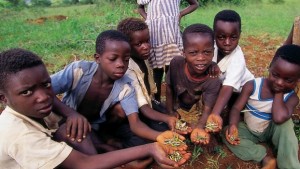The most commonly consumed insect in Africa, according to the Food and Agriculture Organisation (FAO), is the cricket whose consumption preference of either being fried, smoked or dried in the sun depends on local communities.
In Algeria, the desert locust, which is a good protein source is ‘harvested’, soaked in salt water and dried in the sun and eaten mainly by the poor.
Caterpillar eating is common in central African countries and in Botswana, where either the legs of the caterpillars are plucked off and the insect deep-fried, or the gut removed before what is left is cooked.
Studies have shown that in every 100 grammes of dried caterpillars, there are about 53 grammes of protein, 15 per cent of fat and about 17 per cent of carbohydrates — which is a higher content of fat and protein than would be found in a similar amount of beef.
The Mopane worm found mainly in Zimbabwe is huge export business. It is dried and exported to Botswana, South Africa and sometimes onwards to African hotels in Europe.
In May, when the FAO released a report advocating more consumption of insects, it attracted support and criticism in equal measure. The report, Edible Insects: Future Prospects for Food and Feed Security, promotes the creatures as low-fat high-protein diets for people, pets and livestock.
Though currently two billion people eat insects globally, FAO has launched a campaign for their increased uptake as an alternative source of food for the continent’s growing population which is expected to double in 2050.
According to Dr Suresh Raina, a principal research scientist with the Nairobi-based International Centre of Insect Physiology and Ecology (Icipe), the uptake of insects though significant in Africa is greatly hindered by perceptions. “So many people think about what the insects do when they are alive and where they have been and this negative picture actually creates the unpalatability perception in their minds,” he said.
Dr Raina says that urbanisation also plays a role, especially in cases where people who used to eat insects in their rural areas do not now want to be associated with what is seen as poverty.
“The public needs to be educated on the benefits of eating insects because they are more nutritious than red meat,” he said. “Most people are just put off because of the presentation of the cooked insects but if people came up with protein bars and shakes made from insects people would be more receptive.”
The scientist admits that it will, however, take time before “high class” people in African cities walk into a restaurant and order a plate of worms or other edible insects, however, exquisitely they may have been cooked.
In line with the FAO’s campaign, Icipe has already dedicated a department for the mass production of caterpillars and grasshoppers to increase their population in areas where they are highly consumed.
Dr Raina, who is involved in a project to promote beekeeping for pollination purposes in Kenya, also wants to champion the consumption of drones locally and export them to a ready market in Japan.
“Male drones in the hives have now other work apart from populating with the queen bee and studies have shown that they are quite a high source of protein,” he says.
“So apart from farmers having a bumper harvest from the cross pollination and honey which they can sell, they will in time be able to harvest the drones to supplement their food stores,” he said.









